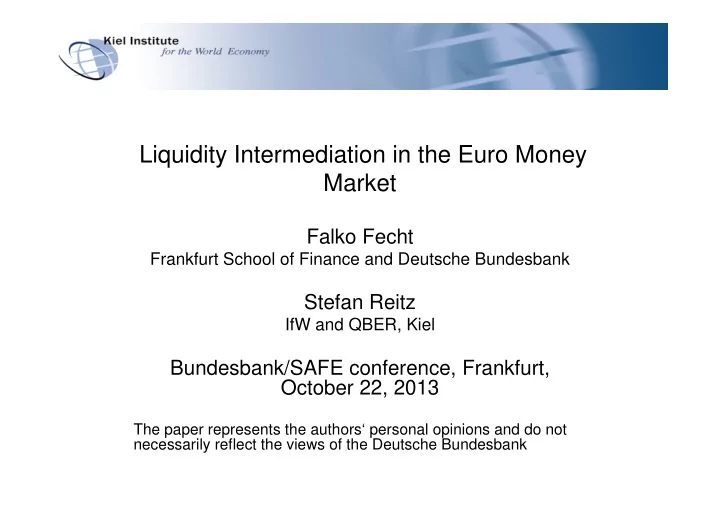

an der Universität Kiel Liquidity Intermediation in the Euro Money Market Falko Fecht Frankfurt School of Finance and Deutsche Bundesbank Stefan Reitz IfW and QBER, Kiel Bundesbank/SAFE conference, Frankfurt, October 22, 2013 The paper represents the authors‘ personal opinions and do not necessarily reflect the views of the Deutsche Bundesbank
an der Universität Kiel Outline of the talk 1. Motivation 2. A Stylized Model 3. Data 4. Empirical Analysis 5. Conclusions Liquidity Intermediation 2
an der Universität Kiel Motivation • Money markets • play pivotal role in the conduct of monetary policy • important for capital allocation and risk sharing between banks • Recent experience showed that limited access to liquidity could severely stress otherwise healthy banks and destabilize the financial system • Observers even talked about a complete freeze of the market Liquidity Intermediation 3
an der Universität Kiel Motivation • Interestingly, we know very little about the trading process in the European money market • More than 80% of the trading occurs in an over-the- counter fashion (The rest is trading via the Italian e-MID platform) • Interest rates are agreed on a bilateral basis and remain unpublished • Complete trading records are undisclosed preventing the knowledge of the exact terms of a trade • (Counterparty risk, maturity, time of the day,….) Liquidity Intermediation 4
an der Universität Kiel Motivation • What has been done so far is to infer market tensions from • indicative quotes (bid/ask) • EONIA/EURIBOR surveys and derivative measures such as the EURIBOR-OIS spread • filtered data from payment system transactions • e-MID data Liquidity Intermediation 5
an der Universität Kiel What we do… • Make use of a propriety data set, which contains the complete set of transactions of a market maker in 2007 and 2008 hereby covering the most important period of the crisis in the money market • Estimate a market microstructure model to infer the trading behavior of a major market maker • Assess the relative importance of asymmetric information in times of crisis Liquidity Intermediation 6
an der Universität Kiel Theoretical Model • Money market trading (OTC) • Banks trade among each other • No trading platform • Asymmetric (private) information important • Leads to an augmented version of the Madhavan and Smidt (1991) pricing model Liquidity Intermediation 7
an der Universität Kiel , Theoretical Model • Full-information price of the overnight interest rate offered to a specific counterparty is supposed to follow a martingale process d 1 2 2 1 2 d , d ~ iid N ( 0 , ) d t t 1 , 2 t t 1 t t • Increments represent • market dynamics of excess liquidity • Counterparty’s idiosyncratic risk in excess of group-specific risk Liquidity Intermediation 8
an der Universität Kiel Theoretical Model • Market maker sets quotes according to • Customer bank’s belief about the true price of liquidity • Customer bank’s excess demand for liquidity is Liquidity Intermediation 9
an der Universität Kiel Theoretical Model • Following Glosten and Milgrom (1985) the market maker considers that order flow is based on a private piece of information • Bayesian learning gives a post-trade expected value • Inserting into the pricing equation gives Liquidity Intermediation 10
an der Universität Kiel Theoretical Model • Pricing eq. cannot be estimated directly because y t is an unobservable variable • Madhavan and Smidt (1991) solution is • The resulting estimation equation is Liquidity Intermediation 11
an der Universität Kiel Data • Tick-by-tick data from a major money market dealer • Data from Jan. 1st, 2007 to Dec. 31th, 2008 (510 trading days, 17,888 transactions) • Trade records contain • date and time of trade • trade direction • deal size • transaction price • maturity • counterparty type and trade initiator Liquidity Intermediation 12
13 Liquidity Intermediation an der Universität Kiel Data
14 Liquidity Intermediation an der Universität Kiel Data
15 Liquidity Intermediation an der Universität Kiel Data
16 Liquidity Intermediation an der Universität Kiel Data
an der Universität Kiel Empirical Analysis Additional control variable • Relationship trading (Cocco et al., 2009)? Is there a discount for frequent trading with the dealer? Include number of trades before the crisis (NoT) • Deal size often turns out to be part of transaction cost pricing schemes. Additionally use deal size in excess of its median (ExMed) p t shows significant autocorrelation • inclusion of lagged price changes up to eighth order p t also driven by monetary policy decisions • inclusion of EONIA changes (current and lagged) Liquidity Intermediation 17
an der Universität Kiel Empirical Analysis • Split up sample: First : Jan. 2007 to Aug. 2007 Second : Aug. 2007 to Sept. 2008 Third : Sept. 2008 to Dec. 2008 • GMM with Newey-West covariance correction • Set of instruments equals the set of regressors (OLS estimates, but do not rely on a specific error distribution) R 2 s nearly 50%, DW in the neigborhood of 2 • Liquidity Intermediation 18
19 Liquidity Intermediation an der Universität Kiel
20 Liquidity Intermediation an der Universität Kiel
21 Liquidity Intermediation an der Universität Kiel
22 Liquidity Intermediation an der Universität Kiel
an der Universität Kiel Conclusions • Propose an OTC money market pricing model • Accounting for microstructure issues such as • adverse selection • inventory control • counterparty-specific spreads • Increasingly unbalanced trading Funds from an increasing number of depositors were lend to a decreasing number of borrowers Liquidity Intermediation 23
an der Universität Kiel Conclusions • During the course of the crisis • Half spreads increased substantially • Inventory considerations and counterparty risk became more important • Confidence in order flow information decreased • Information aggregation process severely hampered • Money market trading severely stress, but not frozen Liquidity Intermediation 24
25 Liquidity Intermediation an der Universität Kiel
Recommend
More recommend